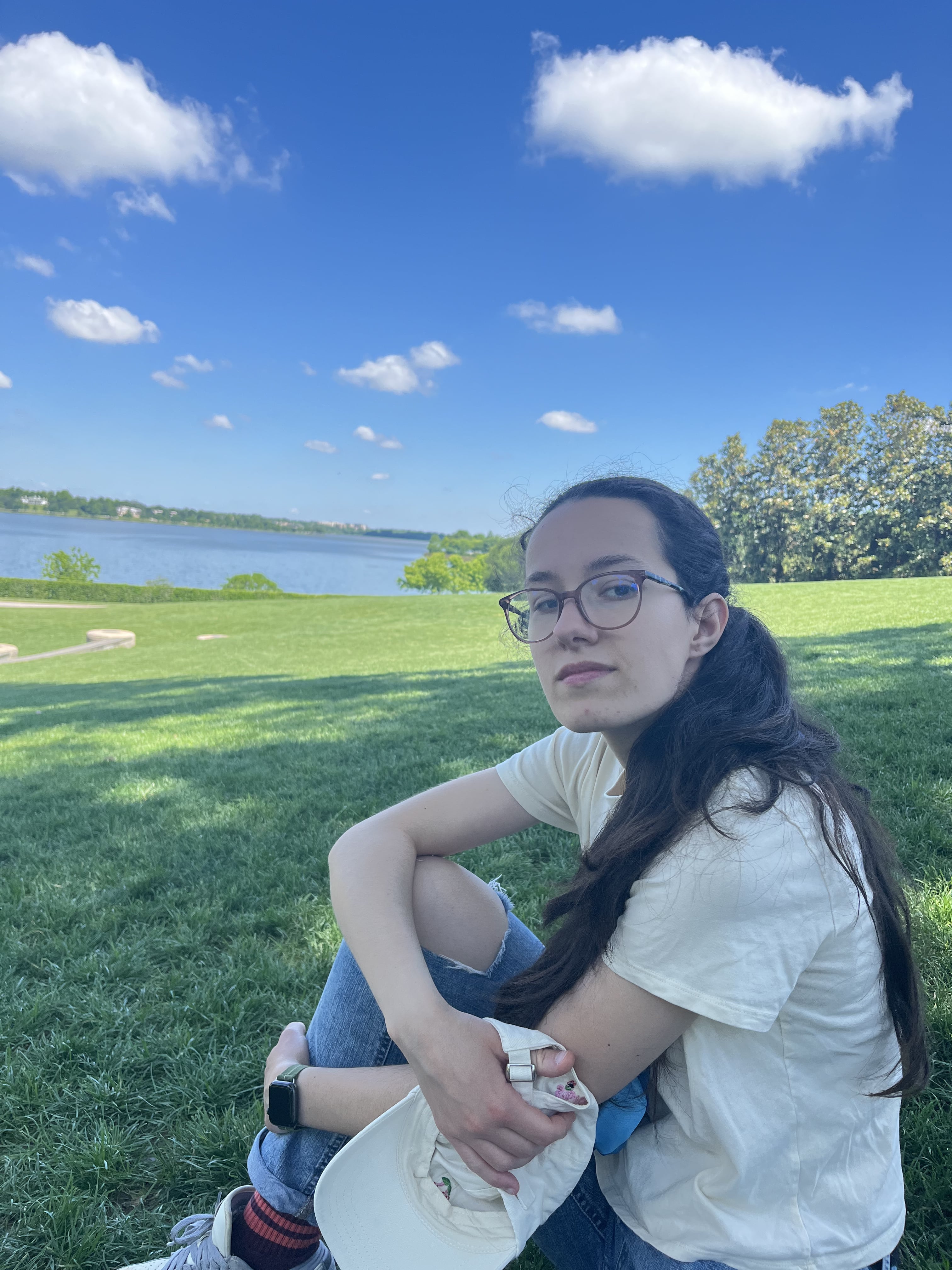Boston Symphony Orchestra over the years
Published:
Exploring 140 years of music performances
The Boston Symphony Orchestra is Boston’s local symphony and one of the major American ensembles. Since its creation in 1881, it has featured thousands of performances, including premieres, seasonal celebrations and special festivals. As a classical music fan and a data nerd, I decided to analyze the BSO’s historical performances, available on their archival database.
In the last 3 decades (1990-2022), the BSO has done around 9700 performances, where 4700 were by the main Symphony Orchestra, 1600 by Pops (the seasonal performance orchestra, composed partially of regular BSO musicians) and 240 by the Chamber Players (a subset of BSO musicians focused on performing smaller chamber works). Seasons start typically in September and end around May whereas during the summer the Symphony plays at the Tanglewood Festival in Western Massachusetts.
Each symphony program typically features 3 pieces; the first is sometimes a shorter composition, and the next two typically full-scale works separated by an intermission. Let’s take a look at which compositions get played first in BSO performances as overtures to the main program. The most played opening piece in the last 3 decades is Berlioz’s Roman Carnival Overture, which has been performed 42 times, setting a lively and festive tone for the concerts. Another popular piece is Debussy’s Prelude to the Afternoon of a Faun, which has captivated audiences with its dreamy and fairytale-like sound.
What about season openers, typically at the end of September? Does the symphony play any special pieces to open or close a program, such as more ceremonial or commemorative ones? For season openers, the most played composers are Beethoven and Mozart, which you’ll see hold for other performances as well. For example, the season opener in 2011 featured Anne-Sophie Mutter who played Mozart’s 3rd and 5th violin concertos. Similarly, other soloists have featured in opening performances throughout the years: including pianists like Lang Lang and violinists like Itzhak Perlman. Season closing performances are a bit more varied: throughout the years, the BSO has featured famous pieces like Mahler’s symphonies, but also pieces by composers like Smetana and Martinu.
Composer popularity in the past 3 decades
Which composers are the most performed since the 1990s? Looking at the frequency of performed pieces, Mozart and Beethoven are significantly more popular than any other composer, which holds for every decade from the 1990s, 2000s, and 2010s. Both of them belong to the Classical period and are followed by Haydn, another Classical era composer who lived and worked earlier than the two of them. The Classical era, spanning roughly from 1750 to 1820, is known for its emphasis on clarity, balance, and formal structure, with composers like Mozart and Beethoven epitomizing its aesthetic ideals. Their works often showcase elegant melodies and structured harmonic progressions, which have contributed to their enduring popularity.
Their popularity, however, has been on the decrease. As you can see in the chart below, while Mozart and Beethoven are the two top composers whose works are performed the most frequently, their pieces are played less and less in the past 30 years. Instead, 20th-century composers such as Strauss and Shostakovich and Pops favorites like Randol Alan Bass have risen in popularity. The 20th century introduced a vast array of styles, from the lush romanticism of Strauss to the emotionally intense and complex works of Shostakovich, reflecting the tumultuous social and political landscapes of the time. Pops concerts, blending classical and popular music, have also contributed to the rising prominence of contemporary composers like Randol Alan Bass, whose works are more accessible and engaging for broader audiences. Interestingly, Bach is also more popular now than in the previous few decades.

Ludwig van Beethoven
Let’s now turn our attention to more specific composers and their music pieces.
Composers like Beethoven are performed by BSO extremely frequently. His music represents the end of the Classical era and the rise of the new Romantic era in music. In the Romantic era, unlike the periods before it, music was personal and emotional. Beethoven’s work spanned 9 symphonies, 5 piano concertos, a violin concerto and 16 string quartets, among his many pieces. Here’s a look into Beethoven’s top 12 most popular pieces and how often they have been played at the BSO:
His 5th symphony (with the famous ‘da-da-da-daaa’ fate theme) was performed very often by the symphony in the 1880s-1980s but less so today:
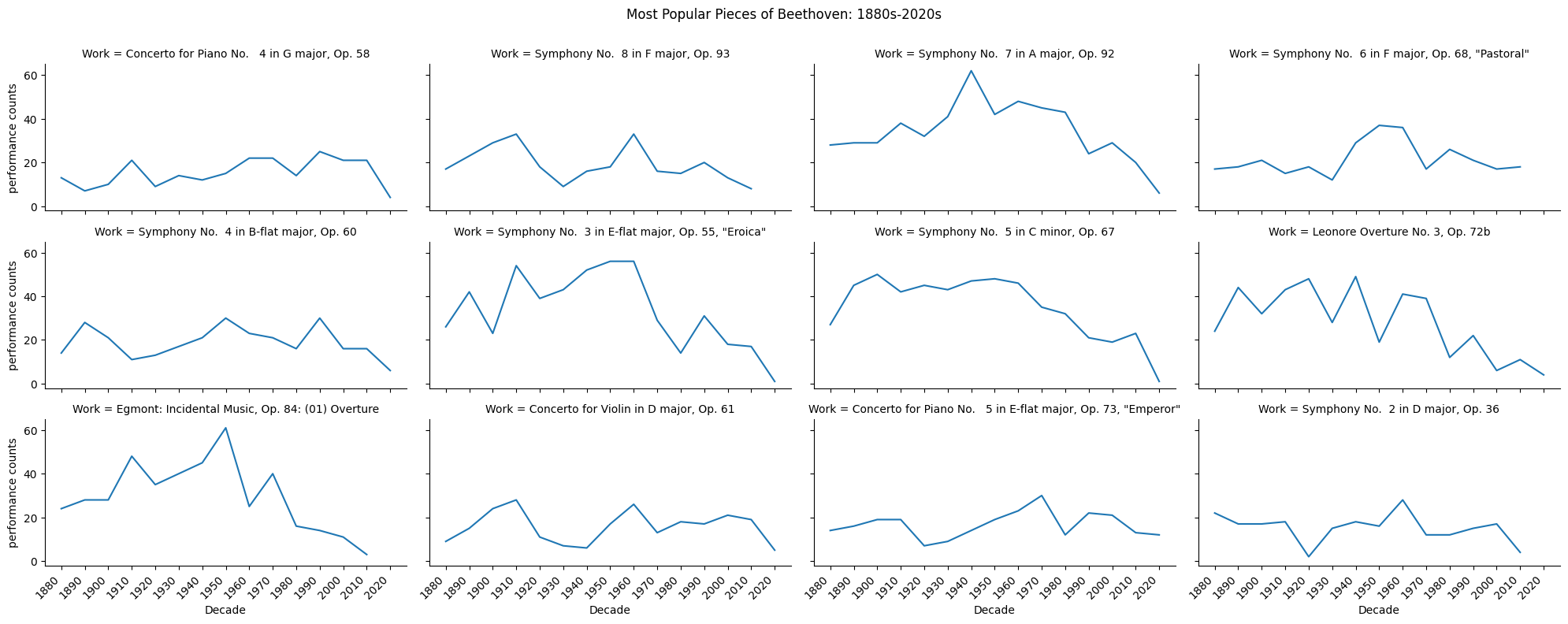
Wolfgang Amadeus Mozart
The other most popular composer similar to Beethoven is Mozart. Mozart belongs to the Classical era of classical music and wrote hundreds of beautiful pieces in his relatively short life. Some of them are among the top performed by the BSO, particularly his operas like The Marriage of Figaro and The Magic Flute, which are celebrated for their masterful blend of captivating melodies, dramatic depth, and comic elements.
Mozart is also known for his symphonies, particularly his last symphony, the 41st, often nicknamed ‘Jupiter.’ This symphony is revered for its grandeur, intricate counterpoint, and majestic finale, which exemplifies Mozart’s skill in weaving together multiple themes into a cohesive, uplifting conclusion. The Jupiter Symphony remains a cornerstone of the symphonic repertoire, showcasing Mozart’s ability to balance complexity and accessibility.
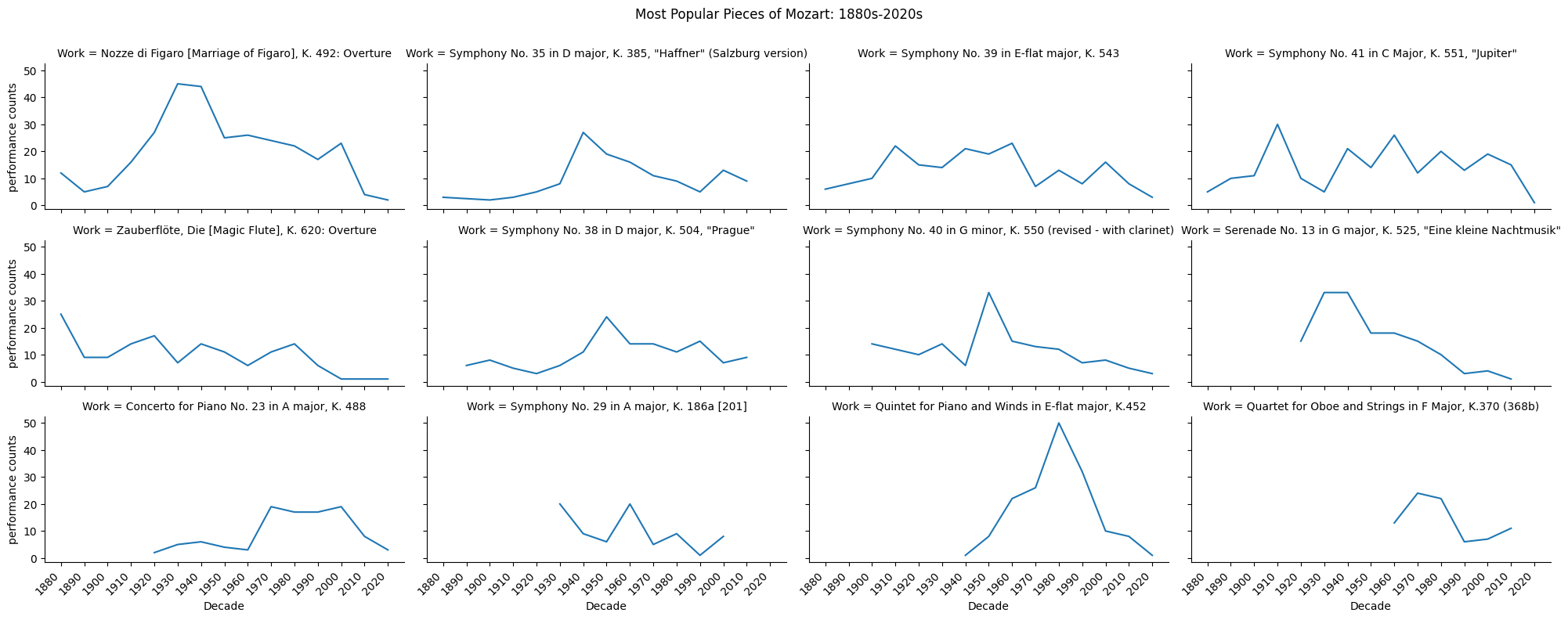
Dmitri Shostakovich
Looking now into composers who have risen in popularity in the past few decades, the Russian composer Dmitri Shostakovich is especially popular in the BSO. Renowned for his ability to convey profound emotional depth and political commentary through music, Shostakovich’s works often reflect the tumultuous socio-political climate of Soviet Russia, blending traditional symphonic forms with modernist elements.
Among his popular works is his famous 5th Symphony, which peaked in popularity around 1940. This symphony, often viewed as a response to Stalinist repression, carries a mix of triumph and tragedy, with its powerful finale frequently interpreted as either a forced triumph or a subtle critique of Soviet authority. His Piano Concerto No. 2 has seen more performances in recent years, showcasing a lighter, more playful side of his compositions, while his Violin Concerto No. 1 remains ever popular today for its intense emotional expression and virtuosic demands. However, many of his other symphonies, such as the 6th, 7th, and 8th, are performed less frequently, despite their rich, complex portrayals of human struggle and resilience.
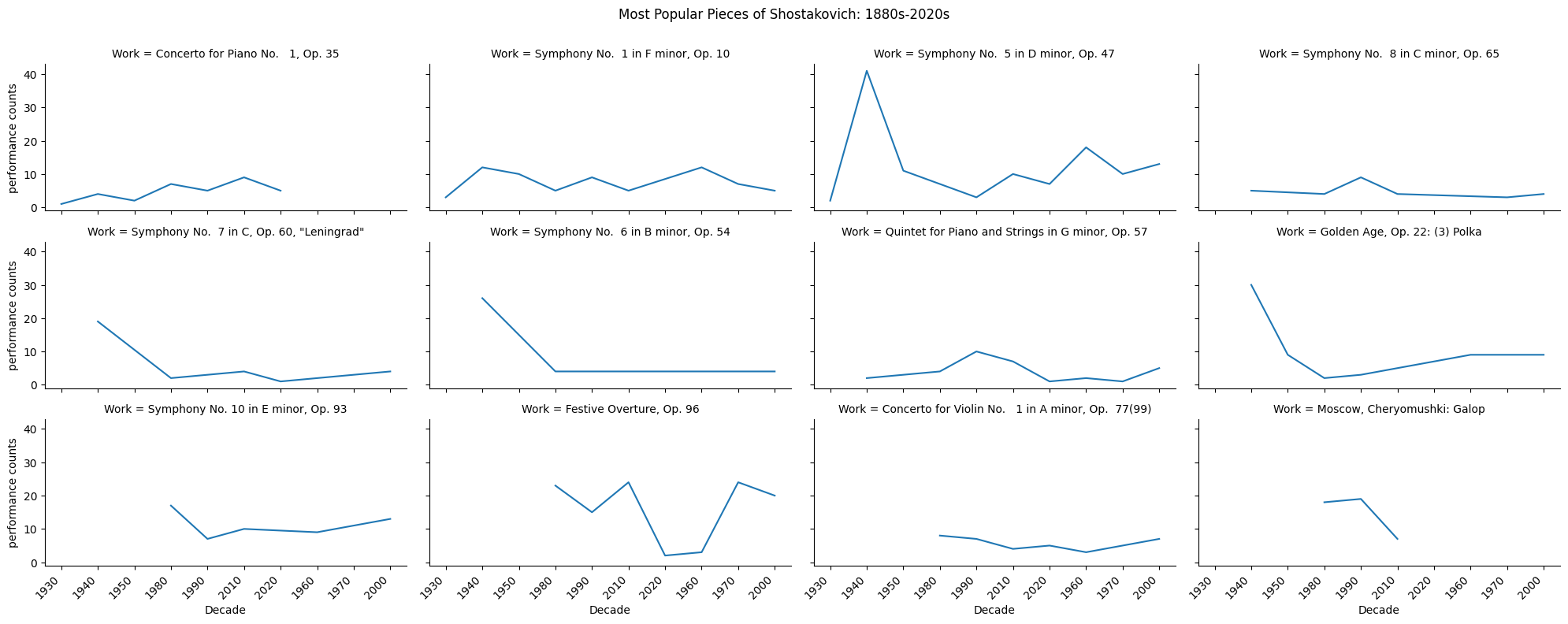
Gustav Mahler
Mahler’s symphonies are always fan favorites. He wrote 10 (the 10th being unfinished), and each of them is a musical journey that spans nature, feelings, literature, and the whole world like nobody else. Each of his symphonies brings something new: his 5th Symphony is famous for its dramatic shifts in mood, particularly the serene and deeply emotional Adagietto. His 8th Symphony, known as the “Symphony of a Thousand,” is an overwhelming, all-encompassing celebration of spiritual and creative power, requiring massive orchestral and choral forces. The 9th Symphony, often interpreted as a contemplation of mortality, is marked by its profound introspection and emotional depth.
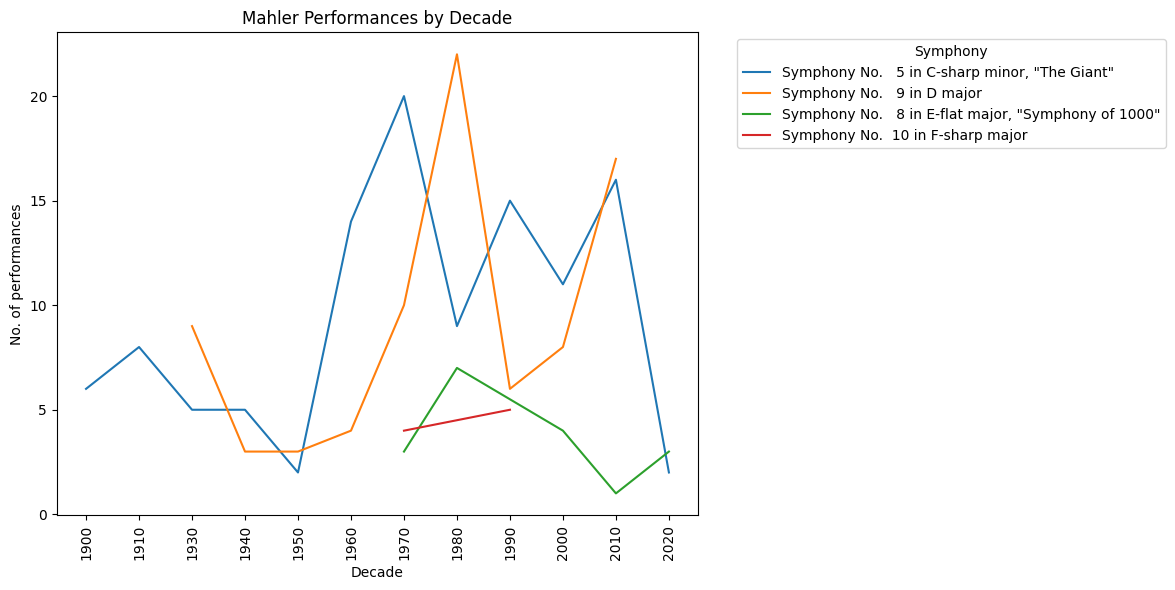
Composers: time and place
This handful of composers accounts for the majority of works played at the BSO, and they are performed hundreds of times over different seasons. However, this is not typical: for most composers, their works are only played a handful of times (or even once). In fact, the BSO has played music by hundreds of different composers, most of which are featured relatively rarely. This is a chart of how often each composer’s music is performed:
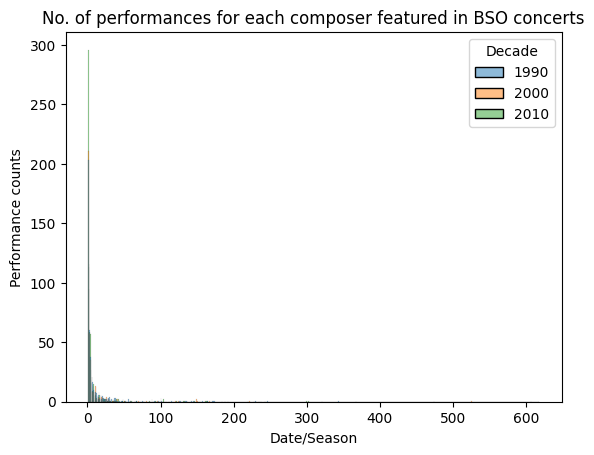
What are some patterns among this long tail of composers? Which countries are they from and what historical periods have they operated in? It turns out that data for these questions is hard to find. For this story, I used musicbrainz to extract data about composers’ personal details through matching them with the names found in the BSO dataset. The musicbrainz API provides some useful data about their birth & death years as well as their countries of origin. The dataset is not complete, however it contains partial information for a couple hundred composers in the past 30 years.
Here’s a plot of composer birth years and the frequency of pieces performed:
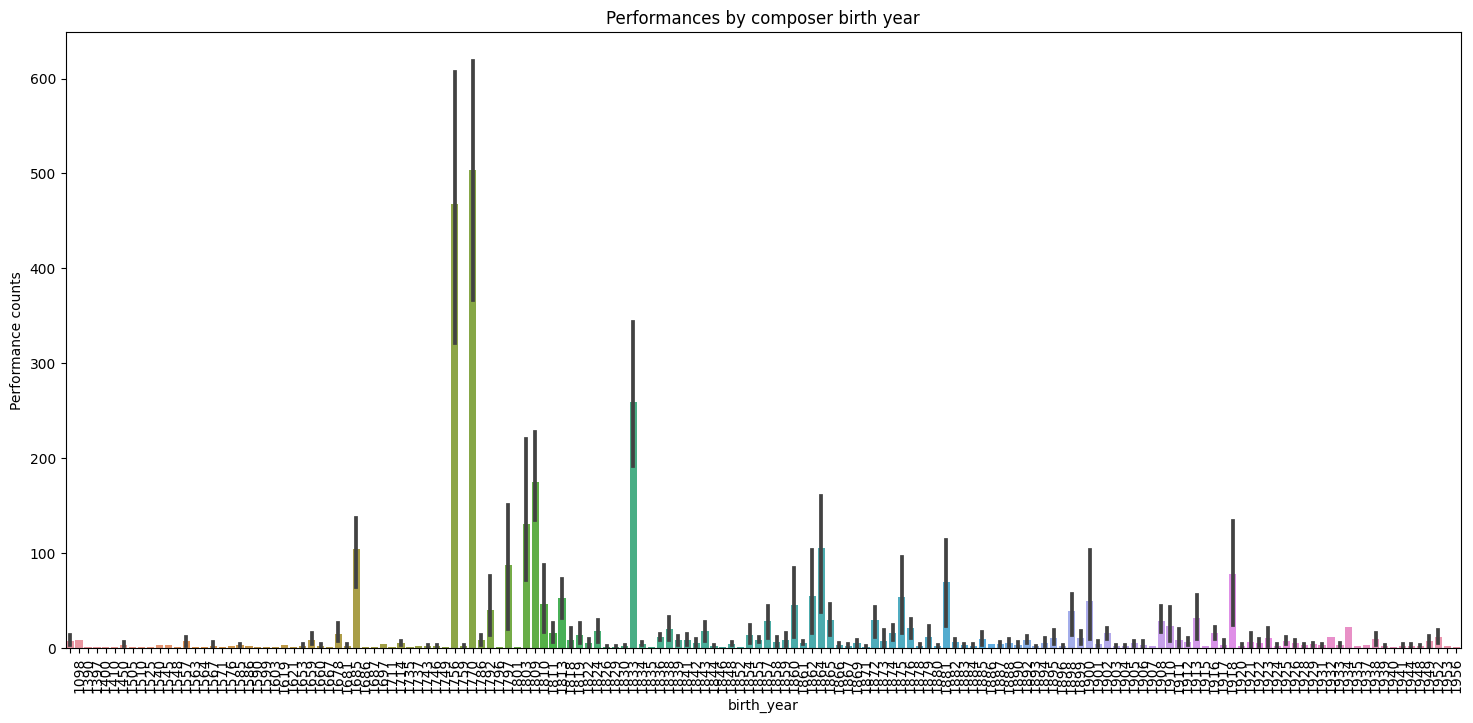
There are three peaks, in 1756-1770 and 1918, corresponding to Mozart, Beethoven and Bernstein. Further, smaller peaks in the late 18th century show that romantic era composers continue to be the most performed, along with those born in the 1850s.
Next, let’s take a look at the nationality of different composers. Here’s a chart of birth years for US- and UK-born composers:
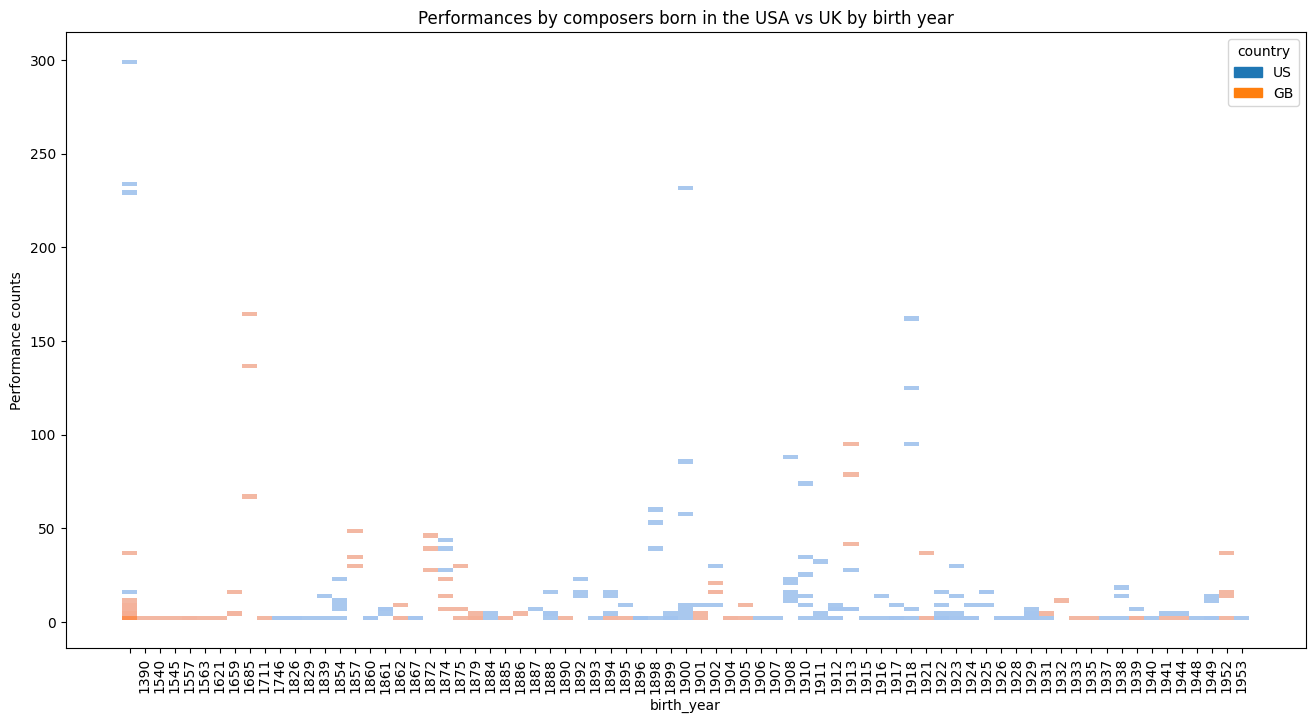
To compare, here’s Italy and France:
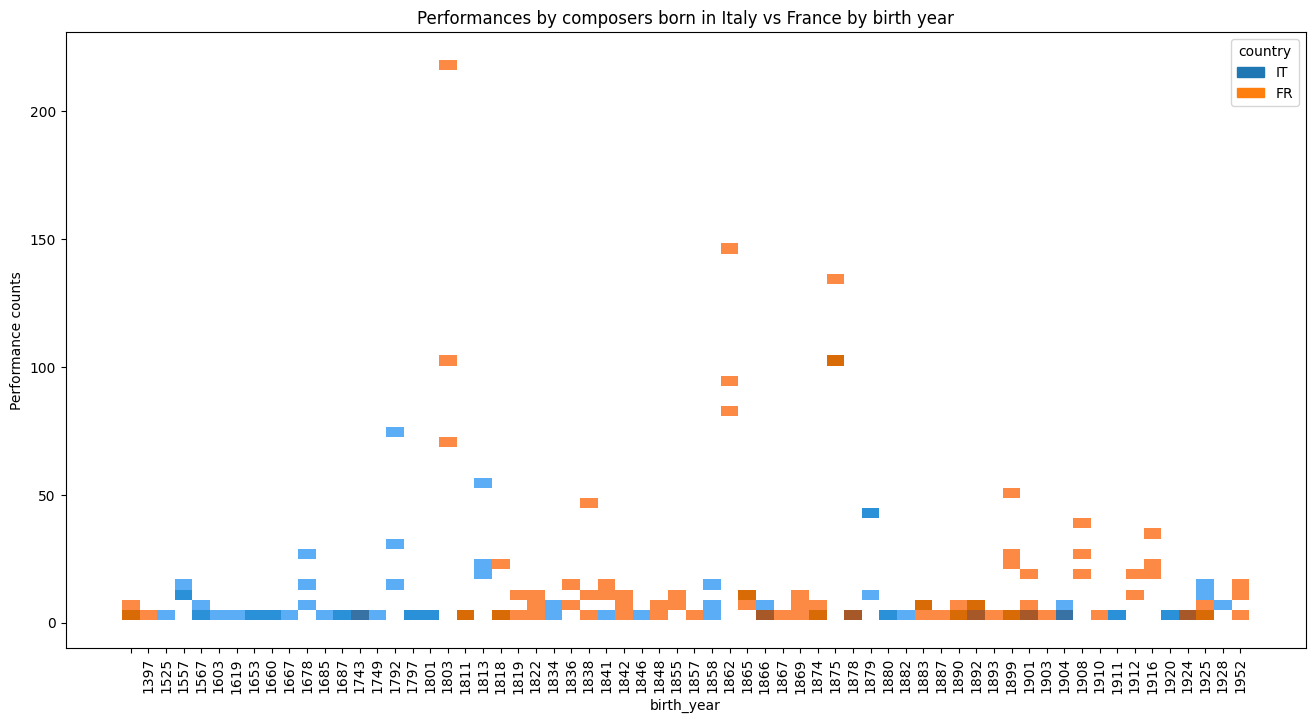
And Germany:

As you can see, the distributions for each of these countries look pretty different, depending on which composers have been the most popular. Italy’s most popular composers, for example, are Monteverdi, who was born in 1567 and Vivaldi, born in 1678 as well as Giuseppe Verdi (1817). France’s most popular composers are all born later: Ravel (1875), Debussy (1862) and Berlioz (1803). In Germany, there are many: from Beethoven, Mendelssohn and Brahms to 20th century composers like Strauss and Wagner.
Soloists: violin
Which soloists are playing can also affect the choice of program. As an amateur violin player, I am curious about how often BSO performs works from the solo violin repertoire. Here are the most common pieces, and you’ll notice the big 5 concertos feature very prominently. Those are Brahms, Sibelius, Beethoven, Tchaikovsky and Mendelssohn concertos, all Romantic-era and very virtuosic.
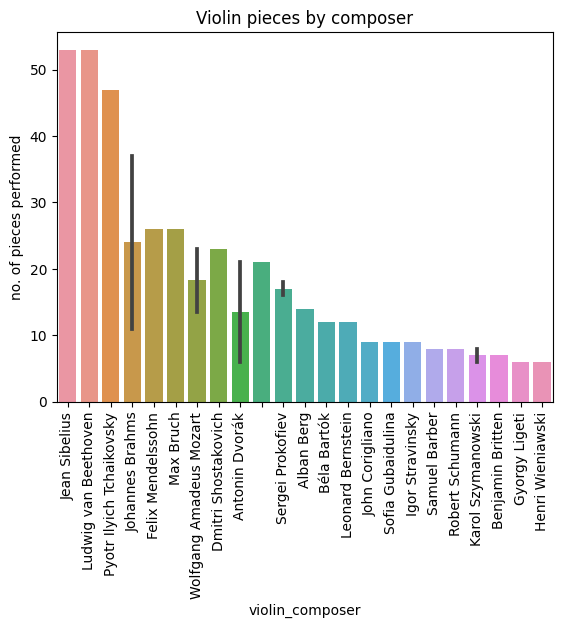
Individual soloists in general tend to play works from 3-4 different composers (with an average of 3.7). However, if we look at their performance history, we can notice more patterns. For instance, some performers only play music by a handful of composers, such as Malcolm Lowe (Mozart) or Baiba Skride (Shostakovich). Others have branched out to multiple composers, like Joshua Bell, Christian Tetzlaff, Frank Peter Zimmerman, Gil Shaham who also play composers that are not heard very often like Schnittke and Glazunov. Here’s a map of soloists and their chosen composers:
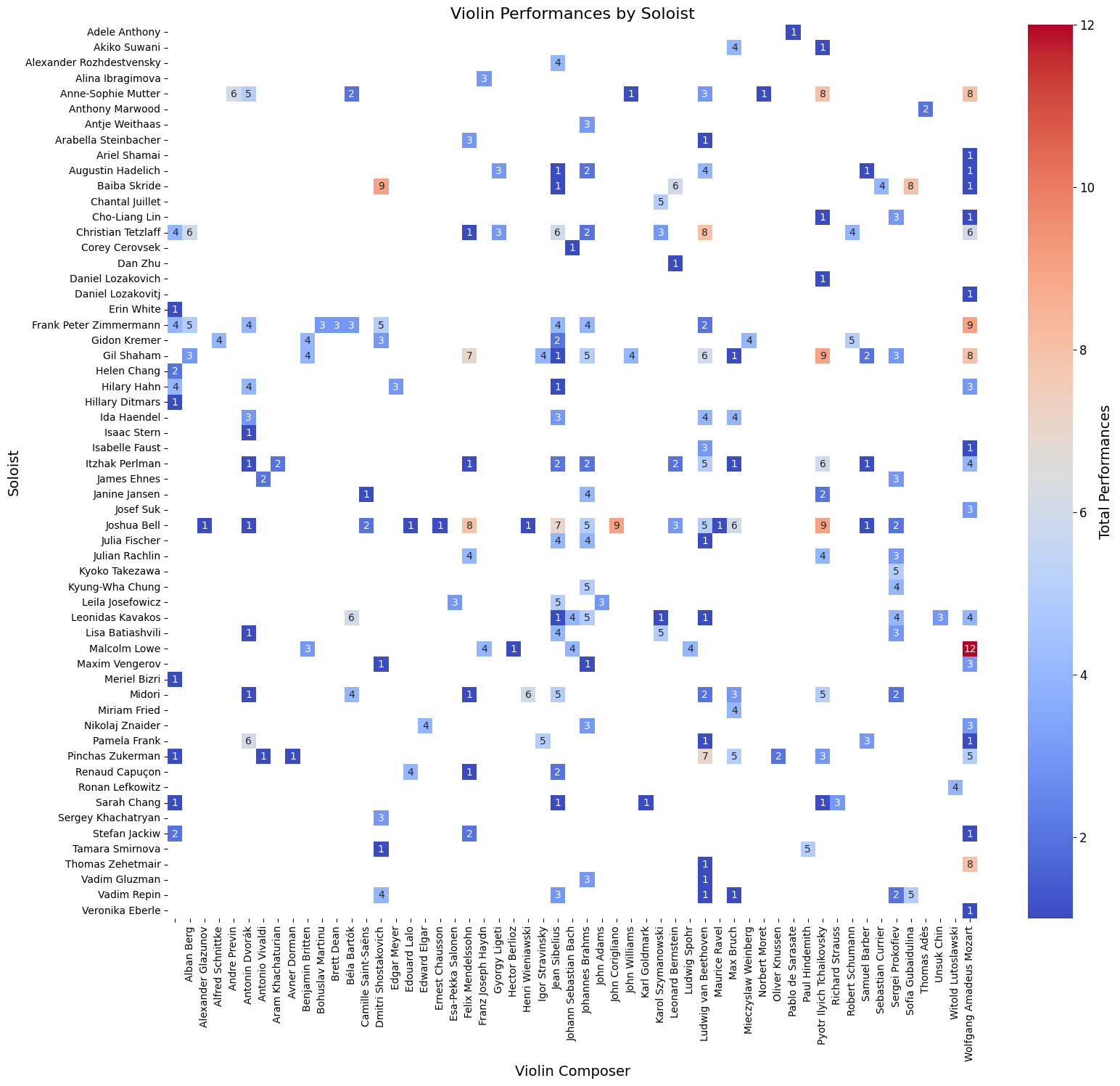
a few closing thoughts
This exploration into the performance patterns of violinists concludes this data story. While I came across a lot of interesting patterns and unexpected findings, I find myself with many more other questions as well. Particularly, I am not very familiar with the rest of the soloistic repertoire, such as piano or cello, which could also be interesting to explore further. Also, I am curious about a lot of music starting in the 20th century and continuing with contemporary composers, whom I don’t know as much about but they seem to have started becoming more and more popular recently. As I learn more about them, particularly newer atonal or minimalist composers, I could come back and look more into these questions as well. All interesting avenues to explore!
Thanks for reading, and let me know what you think!
